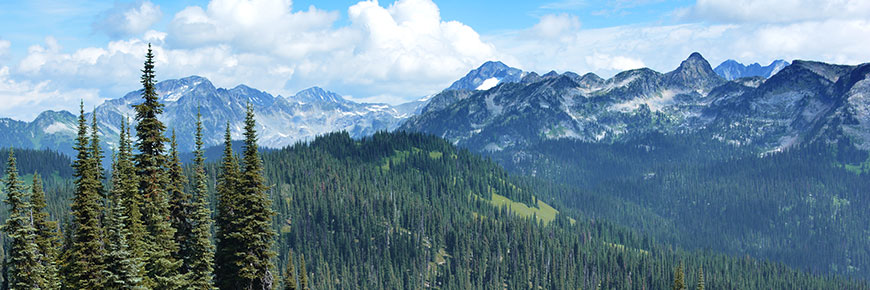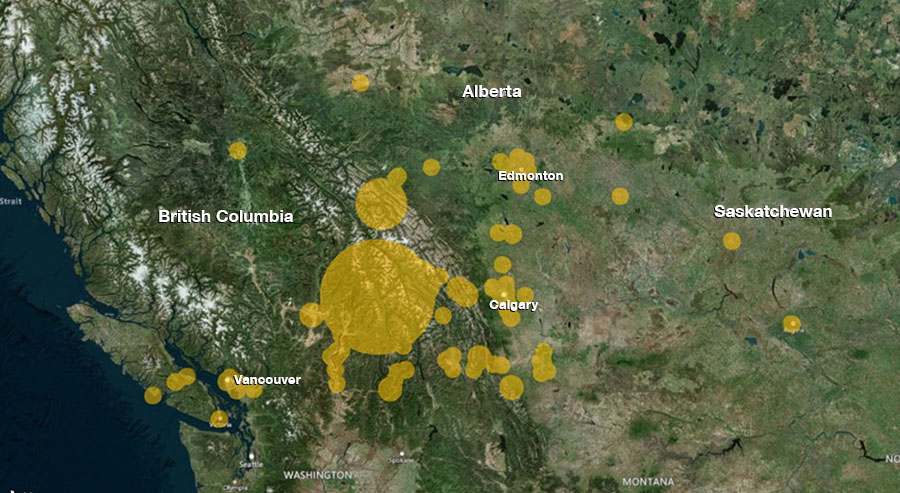
Management planning 2020: what we heard
Mount Revelstoke National Park
The engagement process
Summary of engagement activities
To gather initial feedback in the national park management planning process, Mount Revelstoke and Glacier national parks reached out to Indigenous groups, local and regional communities and other interested Canadians. With each group, Parks Canada provided an overview of achievements since the 2010 management plan, presented the 2018 State of the Park Report, and shared vision elements, issues and opportunities identified through internal review, as starting points for discussions.
In Revelstoke, British Columbia, engagement activities included discussions with Indigenous groups, as well as a public open house, a stakeholder workshop, and outreach at the Revelstoke Mountain Resort and the Revelstoke Secondary School. In collaboration with Yoho and Kootenay national parks, Parks Canada hosted a stakeholder workshop in Golden, British Columbia, and set up a booth at the Golden Farmers Market. Other activities included outreach at Mountain Equipment Coop in Kelowna and the Vernon Farmers Market, as well as a webinar with Campus Club members at Vancouver Island University. In total, Parks Canada team members spoke directly with more than 520 people.
Who we heard from
To reach more Canadians in the region and across the country, Mount Revelstoke and Glacier partnered with the other mountain national parks (Banff, Yoho, Kootenay, Jasper and Waterton Lakes) to host the Let’s Talk Mountain Parks webpages. This online tool allowed people to review background information and comment on considerations for the new management plans. For Mount Revelstoke and Glacier national parks, Parks Canada invited Canadians to visit the website through targeted Facebook ads. Between January 30 and May 16, 2019, the website received over 4,000 visits, more than 400 people registered on the site, and the Mount Revelstoke and Glacier national parks received 226 online submissions. Ninety-five per cent of participants were from Western Canada, split almost evenly between British Columbia and Alberta.

What we heard
What we heard from Indigenous peoples
What we heard from stakeholders and the general public
Both in person and online, Canadians shared a wide variety of ideas, issues and opportunities, ranging from broad landscape-level conservation to specific operational input. From this input, some clear themes emerged that will guide development of a draft management plan.
Vision
Both online and in the various workshops, we asked Canadians about their vision for Mount Revelstoke and Glacier national parks in 15 to 20 years. The top responses online were:
- The natural wonders of the Columbia Mountains are valued and understood;
- Ecological integrity within the parks is the priority and decision-making is guided by conservation science;
- Shared protection and conservation goals for the Columbia Mountains’ ecosystems, landscapes and biodiversity are achieved in collaboration with governments and partners;
- Visitors are inspired to be environmental stewards; and
- Research in the parks contributes to an understanding of the impacts of climate change within and beyond park boundaries and guides collaboration with governments and partners.
These vision statements were echoed throughout the public engagement process as being important for the future of the parks.
Visitation
Across all themes, we heard concerns related to increasing visitor numbers. Parks Canada should:
- Ensure that the needs of visitors are met, including adapting to new and changing markets (increasing international tourism, visitor profiles, aging demographics), and diversifying experiences (new signature experiences, more interpretive programs and virtual tourism opportunities);
- Manage visitor impacts on Mount Revelstoke and Glacier national parks and maintain the quality of experience by limiting access, managing visitor expectations, and diverting use spatially or seasonally;
- Connect visitors to these special places and inspire them to be park stewards; and
- Manage use and activities to ensure the safety of visitors and wildlife.
Accessibility
We heard that Parks Canada should improve access to Mount Revelstoke and Glacier national parks for all users regardless of age or ability. Understanding that not all areas of the park can meet the needs of everyone, we heard interest in diversifying how people can experience the parks. For example:
- Barrier-free or adaptive trails;
- Visitor facilities that can be accessed, used independently, and understood by a wide range of visitors (universal design);
- Restoring historic trail systems and/or creating new loop trails to disperse visitors and provide a variety of experiences; and
- Assessing opportunities with consideration for aging demographics and different cultures.
Assets and infrastructure
We heard that Parks Canada should invest in the maintenance and improvement of existing assets. For new investments, many people want to see environmentally sustainable operations and infrastructure. Four key areas of interest were:
- Trail maintenance and design that takes into account increasing visitation;
- Basic amenities and more overnight opportunities in the Rogers Pass area;
- More backcountry campsites or cabins for multi-day backcountry trips; and
- Trans-Canada Highway safety improvements including bringing it up to four lanes through both Mount Revelstoke and Glacier national parks, and wildlife crossings.
Ecological integrity
Echoing Parks Canada’s mandate, we heard that ecological integrity should be the priority in Mount Revelstoke and Glacier national parks. Within this theme, Parks Canada heard the following key issues (supported by 75% or more of online participants):
- Reduce impacts of the transportation corridor on wildlife and ecosystem health by improving wildlife movement through the corridor in water and on land, and reducing the impact of spills and wildlife attractants along the highway and railway;
- Protect intact ecosystems. We heard some reluctance to limiting access to the parks, but many comments supported managing visitation to protect sensitive environments through seasonal or area closures, quotas and education;
- Consider visitor safety while protecting the parks through wildfire risk reduction, and assessing and mitigating visitor activities that could increase the risk of human-wildlife conflict issues (dogs off leash, winter recreational activities and the new Mount Revelstoke campground);
- Prioritize ecosystem restoration and protection with decision-making guided by on-going research and monitoring programs in the parks. This includes taking action to prevent new threats and manage existing concerns from invasive species, insects and disease, and contributing to the long-term recovery of species at risk; and
- Be a leader in climate change research. In Mount Revelstoke and Glacier national parks, this includes ongoing monitoring of glaciers, wildfire activity, weather patterns and invasive species. Link these local changes to larger trends and patterns, and share this information widely.
Communications and education
Parks Canada heard feedback on how we share the stories and information about Mount Revelstoke and Glacier national parks with park visitors and Canadians, in their homes and communities. Areas to improve include:
- Communication on appropriate behaviour in national parks. This information should be available during trip planning, in the parks and in different languages;
- Story telling related to Indigenous history and culture, mountaineering and railway history, and conservation, restoration and snow science work in the parks;
- Youth programs, both in and out of the park;
- Citizen science or volunteering opportunities;
- Regular communication with communities and stakeholders to help them understand how park management decisions are made; and
- Information needs to be easier to access and share, and provided in a variety of formats (focus on digital).
We heard two different perspectives on whether Parks Canada should promote the parks:
- Promote the “escape to nature” experience, conservation, and the connections between nature and health (both physical and mental); and
- Do not promote the parks in order to maintain quiet and wild experiences currently enjoyed in Mount Revelstoke and Glacier national parks.
Indigenous relations
Parks Canada heard from many people that they are unaware of Indigenous cultures, histories and traditional territories in the area. Comments identified the need to involve Indigenous peoples in protecting and sharing the area’s natural and cultural heritage, and in decision-making for the parks.
Partners and stakeholders
Collaboration with others is integral to achieve conservation goals, support local economies and tourism, and to foster the next generation of park stewards. We heard that Parks Canada should:
- Think beyond boundaries and restore connectivity to maintain the integrity of the Columbia Mountains ecosystem for wide-ranging species like grizzly bears and caribou;
- Strengthen relationships and work closely with Indigenous peoples, neighbouring land managers, local stakeholders and other governments to align goals that support wildlife diversity and healthy ecosystems across the Columbia Mountains;
- Work with partners and stakeholders to address common issues such as wildlife attractants or invasive species;
- Work with local communities on sustainable tourism opportunities, assess market demand and current opportunities, collaborate on regional promotions and product offers, and build on the history and sense of place of the region; and
- Many people, including regional high school and university students, think we should get more youth into Mount Revelstoke and Glacier national parks and inspire future park stewards. This includes in the parks and at-school learning, research opportunities for post-secondary students, and youth programs that connect the mental and physical health benefits of getting out in nature.
Other areas of interest
We heard specific interest in three key areas of Mount Revelstoke and Glacier national parks:
- In Rogers Pass, Parks Canada should provide additional amenities, and maintain or improve the Winter Permit System and access to the backcountry;
- At the summit of Mount Revelstoke, Parks Canada needs to address overcrowding including maintaining or redesigning trails to accommodate increased numbers or visitors; reducing parking pressures by managing access and/or providing a shuttle service; and addressing human-wildlife conflict concerns; and
- Parks Canada should invest in diverse opportunities in and around the Beaver Valley area of Glacier National Park such as family-friendly day use opportunities, mountain biking, and re-establishing multi-day backcountry opportunities (camping or cabins) in the Beaver Valley, Bald Hills and Copperstain areas.
Operations
Parks Canada also received many comments on current operations including opening/closing times, trail or facility conditions, and the Winter Permit System, to name a few. These comments are being compiled to share with operational staff in Mount Revelstoke and Glacier national parks.
- Date modified :